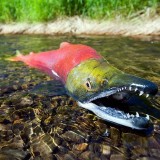Dr. Gordon Hartman is a retired senior biologist and manager for the Department of Fisheries and Oceans with a deep knowledge of the region affected by the proposed Enbridge Northern Gateway Pipeline. Here he provides an essential summary of the threats from the pipeline to fish populations as well as the very real geological concerns surrounding the project.
Introduction
There are very serious and reasonable concerns about the risk of tanker traffic accidents as the ‘oil’ starts its 150+ km tanker journey from near Kitimat, through the narrow Douglas Channel to the open ocean. A report by Anthony Swift and four other authors presents a ‘must read’ review, “Pipeline and Tanker Trouble: The Impact to British Columbia’s Communities, Rivers, and Pacific Coastline from Tar sands Oil Transport”.
The following short article examines three of the specific risks that exist in the 1,170 km double pipeline before the oil ever gets to the tankers. In the report by Anthony Swift and others, 11 ‘special places at risk’ are listed.
In the proposed ‘double line’ system up to 525,000 barrels/day, of bitumen and a diluting condensate, are to be pumped ‘westward’ in a 91 cm pile line. Diluting condensate, from off shore, is to be pumped ‘eastward’ at a rate of up to 193,000 barrels/day (Bustard and Miles 2011). A major failure, caused by an event such as a landslide, would release materials from both lines.
The following article is based, to a large degree, on the articles that are listed at the end. Such a list is clearly not comprehensive. Regardless of that, because they are based on work done by people with decades of competent professional experience, it is clear that there are serious risks along the line before the oil ever reaches the tankers. Pipeline spills into rivers in Northwest B.C. mountains: ‘not if, but when’.
Geological Concerns
The proposed corridor crosses three different physiographic units, each of which presents different hazards to a pipeline. “The geology and geomorphology of west central B.C is complex and destructive landslides are common. Various landslide types have occurred along the proposed pipeline corridor within the defined physiographic units:” (Schwab 2011). The types of landslide and the risks are discussed in this paper.
There are three things that are important to note:
- There are several kinds of slope failures that may affect land uses below them
- Some of these landslides originate far upslope, travel several km, and become large and destructive. Remedial measures are not easy to plan for
- Most of the dated and large landslides are associated with wet, warm, weather. Climate change patterns suggest conditions will become warmer and wetter.
These points barely touch on the details of Schwab’s report. However, they should indicate, even for starters, that much of the approximately 220 km western end of this proposed corridor is a risky and problematic route in which to build large, double, high volume oil pipelines.
Risks to a Population of Large, Biologically Distinct, Rainbow Trout
A paper by Hagen (2011) presents special concern about risks to the habitat of a race of large and unique Rainbow trout. The proposed route crosses the upper reaches of the Sutherland River, at the eastern end of Babine Lake. This river supports a population of large, biologically distinct Rainbow trout.These fish are similar to the world famous Gerrard Rainbow trout from Kootenay Lake.
The proposed pipeline route ‘traverses through the upper portion of the core spawning and rearing habitats’ of the Sutherland River trout. About 95% of the area below the pipeline crossing of the Sutherland River has been rated by the Provincial Protected Areas Team as having ‘very high conservation values’.
The remoteness, complex habitat, and very limited access of the drainage make the Sutherland River a very difficult area to reach if a pipeline break and spill were to occur at its upper end.
This population of fish contributes, in a major way, to the economically and socially valuable trout fishery of Babine Lake. Furthermore, no other population of large, piscivorous, Rainbow trout has been identified in Babine Lake.
Risks to a High Production Section of the Morice River
Some of the most serious risks to fish habitat and populations, along the route, occur in a 71 km section of the pipeline traversing areas adjacent to the upper reaches of the Morice River and Gosnell Creek. In a 34 km section of the river (Reach 2 in the report), the pipeline is located in, or adjacent to, the floodplain with its “numerous active secondary channels, log jams and wetlands that comprise the core spawning and rearing habitat for Morice River fish populations.” (Bustard and Miles 2011).
In a near hundred page report Bustard and Miles provide in-depth information on the biology and numbers of summer run Steelhead and Chinook, Coho, Sockeye and Pink salmon that use this critical section of the river. Their report examines the impacts of an oil spill within this section of river. It considers downstream impacts in the Morice and Bulkley rivers.
In order to provide a context for comparisons they review three past oil spills; Exxon Valdez, Pine River, and Kalamazoo River. They describe cleanup effectiveness of these spills.
Fish Populations
The section of river upstream from Moricetown (near Smithers) supports an important part of the salmon populations of the Skeena River system. The mean annual escapements of Coho salmon, 1997 – 2010, upstream from Moricetown, are 35,000. From 30 to 40 % of these fish spawn within Reach 2 of the Morice River. The complex river habitat in Reach 2 is ideal for Coho salmon juvenile rearing.
The Morice-Nanika Sockeye stock, 8,000 to 10,000 fish, is the largest in the Bulkley system. Reach 2 is the migration corridor for these fish.
The Morice River is the most important Chinook salmon river in the Skeena watershed. Spawning populations have averages slightly over 10,000 during the last decade. Between 35 and 45% of the young Chinook salmon rearing between Morice Lake and Smithers occur in Reach 2.
The Morice River, upstream from Moricetown, supports the largest Steelhead run in the Skeena River system – average of 19,000 fish per year. Steelhead juveniles rear, preferably, in the log jam habitat of Reach 2.
Other fish species in the Morice River system include Bull trout, Mountain whitefish, Prickly sculpins and Pacific lamprey. These species may not be rated so highly for commercial or recreational use, however, they are important parts of the river system.
Oil Spill Impacts
A pipeline break along the Morice River would spread hydrocarbons through Reach 2 could contaminate a large number of log jams – the habitat of juvenile salmonids winter and summer. There are an estimated 1,000 log jams in this reach. Within this approximately 34 km of braided river habitat there is an estimated 370 km of river shoreline. The degree of ‘habitat oiling’ would depend on river level. However, it is evident that a spill above, or in upper Reach 2 would have an immediate toxic impact on fish spawning and rearing in this section.
As the oil and diluting component mix moved downstream, progressively more of the diluting component would evaporate. With this evaporation, the increasingly concentrated bitumen would sink and become incorporated in the streambed leading to long term impacts, especially for salmon egg development.
In Reach 2, eggs or alevins are present in the gravels year- around. Juvenile Chinook, Coho and Steelhead are also in this reach every month of the year. The ‘oiling’ and cleanup of this section of the river would totally alter the channel structure and log jam habitat for such fish. It could not be re-built as it was before a spill.
Where the bitumen became ‘imbedded’ along the many km of river habitat, adequate removal would be nearly impossible. Below a spill in Reach 2, the oil “could very quickly reach downstream habitats in the lower Morice and Bulkley rivers, and potentially the Skeena River.” (Bustard and Miles 2011). The average velocity of the Morice River between May and November is at least 1 m/sec. – too fast for containment booms. A spill in Reach 2 of the Morice River would take 12 hours to reach a point near Smithers.
Bustard and Miles conclude by describing the array of difficulties in effectively capturing and cleaning up spilled oil in Reach 2. The location is remote, access is poor, the river is large and fast, the channel is large and complex, and the ‘enormous’ volume of woody debris would limit boat access to many reach sections. To the date of their writing, the proponent has not provided the information needed to show that an oil spill adjacent to Reach 2 could be effectively controlled or remediated.
There are other sections of the pipeline along which there are other concerns. The cumulative risks and impacts of pipeline breaks along with the potential for tanker accidents make the whole project one of folly, risk and ecological disaster. Surely, we can do better.
G.F. Hartman, February, 2012
References and reading
Bustard, D. and M. Miles. 2011. Potential effects of an oil pipeline rupture on Reach 2 of the Morice River. A submission to the Joint Review Panel: Enbridge Northern Gateway project. 100 p. http://northwestinstute.ca/
Hagen, J. 2011. Rainbow Trout of the Sutherland River in the Babine Lake Watershed, British Columbia, and Risks Associate with the Northern Gateway Pipeline. A Submission to the Enbridge Northern Gateway Project Joint Review Panel. 15 p.
Levy, D. 2009. Pipelines and salmon in Northern British Columbia. Prepared for the Pembina Institute. 46 p. http://pembina.org/pub/1894
Schwab, J. 2011. Hillslope and Fluvial Processes Along the Proposed Pipeline Corridor, Burns Lake to Kitimat, West Central British Columbia. Prepared for Bulkley Valley Centre for Natural Resources Research and Management. 27p. http://www.bvcentre.ca/
Skeena Wild. Enbridge. 2011? Project Overview. http://skeenawild.org/conservation-issues/enbridge/
Swift, A., N. Lemphers and three co-authors. 2011. Pipeline and Tanker Trouble: The Impact to British Columbia’s Communities, Rivers, and the Pacific Coastline from Tar sands Oil Transport. 30 p. http://www.pembina.org/pub2289







